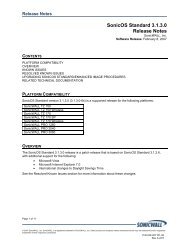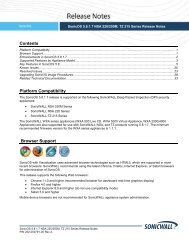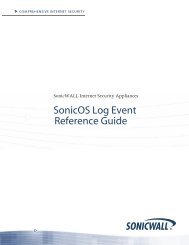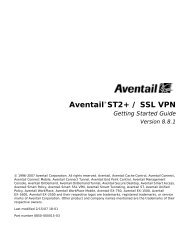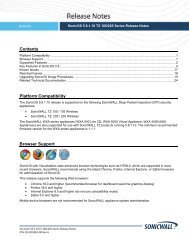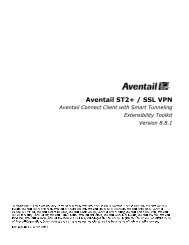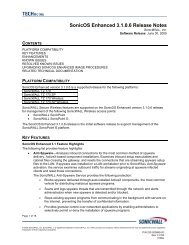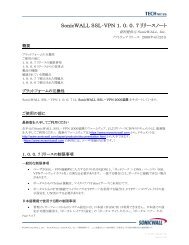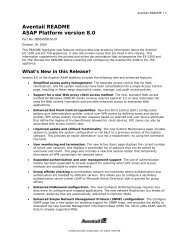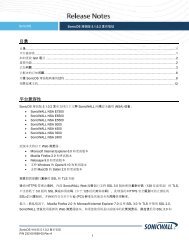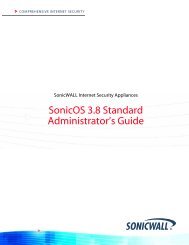SonicOS 5.8.1.13 Release Notes - SonicWALL
SonicOS 5.8.1.13 Release Notes - SonicWALL
SonicOS 5.8.1.13 Release Notes - SonicWALL
You also want an ePaper? Increase the reach of your titles
YUMPU automatically turns print PDFs into web optimized ePapers that Google loves.
• Preservation of Anti-Virus Exclusions After Upgrade⎯ <strong>SonicOS</strong> includes the ability to detect if the starting<br />
IP address in an existing range configured for exclusion from anti-virus enforcement belongs to either LAN,<br />
WAN, DMZ or WLAN zones. After upgrading to a newer firmware version, <strong>SonicOS</strong> applies the IP range to a<br />
newly created address object. Detecting addresses for other zones not listed above, including custom zones, is<br />
not supported.<br />
Anti-virus exclusions which existed before the upgrade and which apply to hosts residing in custom zones will<br />
not be detected. IP address ranges not falling into the supported zones will default to the LAN zone. Conversion<br />
to the LAN zone occurs during the restart process. There is no message in the <strong>SonicOS</strong> management interface<br />
at login time regarding the conversion.<br />
• Comprehensive Anti-Spam Service (CASS) 2.0⎯The Comprehensive Anti-Spam Service (CASS) feature<br />
provides a quick, efficient, and effective way to add anti-spam, anti-phishing, and anti-virus capabilities to your<br />
<strong>SonicWALL</strong> security appliance. This feature increases the efficiency of your <strong>SonicWALL</strong> security appliance by<br />
providing you the ability to configure user view settings and filter junk messages before users see it in their<br />
inboxes. The following capabilities are available with CASS 2.0:<br />
o<br />
o<br />
o<br />
o<br />
o<br />
The Email Security Junk Store application can reside outside the Exchange Server system, such as on<br />
a remote server.<br />
Dynamic discovery of Junk Store user interface pages feature allows the Junk Store to inform <strong>SonicOS</strong><br />
of a list of pages to display under Anti-Spam in the <strong>SonicOS</strong> left hand navigation pane. For example,<br />
the pane might show Junk Box View, Junk Box Settings, Junk Summary, User View Setup, and/or<br />
Address Books.<br />
User-defined Allow and Deny Lists can be configured with FQDN and Range address objects in<br />
addition to Host objects.<br />
A GRID IP Check tool is available in the Anti-Spam > Status page. The <strong>SonicWALL</strong> administrator can<br />
specify (on-demand) an IP address to check against the <strong>SonicWALL</strong> GRID IP server. The result will<br />
either be LISTED or UNLISTED. Connections from a LISTED host will be blocked by the <strong>SonicWALL</strong><br />
security appliance running CASS (unless overridden in the Allow List).<br />
A parameter to specify the Probe Response Timeout is available in the Anti-Spam > Settings page<br />
Advanced Options section. This option supports deployment scenarios where a longer timeout is<br />
needed to prevent a target from frequently being marked as Unavailable. The default value is 30<br />
seconds.<br />
• Enhanced Connection Limiting⎯Connection Limiting enhancements expand the original Connection Limiting<br />
feature which provided global control of the number of connections for each IP address. This enhancement is<br />
designed to increase the granularity of this kind of control so that the <strong>SonicWALL</strong> administrator can configure<br />
connection limitation more flexibly. Connection Limiting uses Firewall Access Rules and Policies to allow the<br />
administrator to choose which IP address, which service, and which traffic direction when configuring<br />
connection limiting.<br />
• Dynamic WAN Scheduling⎯<strong>SonicOS</strong> 5.8 supports scheduling to control when Dynamic WAN clients can<br />
connect. A Dynamic WAN client connects to the WAN interface and obtains an IP address with the PPPoE,<br />
L2TP, or PPTP. This enhancement allows the administrator to bind a schedule object to Dynamic WAN clients<br />
so that they can connect when the schedule allows it and they are disconnected at the end of the configured<br />
schedule. In the <strong>SonicOS</strong> management interface, a Schedule option is available on the WAN interface<br />
configuration screen when one of the above protocols is selected for IP Assignment. Once a schedule is<br />
applied, a log event is recorded upon start and stop of the schedule.<br />
<strong>SonicOS</strong> <strong>5.8.1.13</strong> <strong>Release</strong> <strong>Notes</strong><br />
P/N 232-002239-00 Rev A<br />
40



